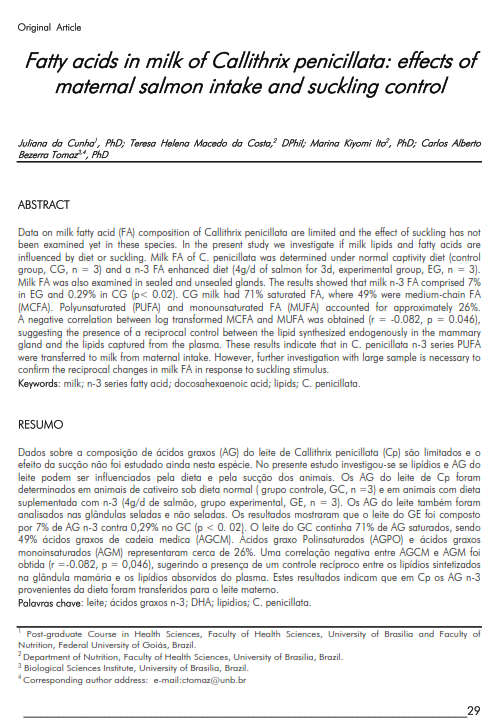Fatty acids in milk of Callithrix penicillata: effects of maternal salmon intake and suckling control.
- Categoria: Volume 74 - Janeiro/Março de 2011
- Autor: Teresa Helena Macedo da Costa, Marina Kiyomi, Carlos Tomaz
- Páginas: 14
- Preço: Faça o cadastro para download
- ISSN: 1807-9865
- Biblioteca: Neurobiologia
- Ano: 2011
-
Link:
 Download
Download
Comentário
Fatty acids in milk of Callithrix penicillata: effects of maternal salmon intake and suckling control
Juliana da Cunha1, PhD; Teresa Helena Macedo da Costa,2 DPhil; Marina Kiyomi Ito2, PhD; Carlos Alberto
![]() Bezerra Tomaz3,4, PhD
Bezerra Tomaz3,4, PhD
ABSTRACT
Data on milk fatty acid (FA) composition of Callithrix penicillata are limited and the effect of suckling has not been examined yet in these species. In the present study we investigate if milk lipids and fatty acids are influenced by diet or suckling. Milk FA of C. penicillata was determined under normal captivity diet (control group, CG, n = 3) and a n-3 FA enhanced diet (4g/d of salmon for 3d, experimental group, EG, n = 3). Milk FA was also examined in sealed and unsealed glands. The results showed that milk n-3 FA comprised 7% in EG and 0.29% in CG (p< 0.02). CG milk had 71% saturated FA, where 49% were medium-chain FA (MCFA). Polyunsaturated (PUFA) and monounsaturated FA (MUFA) accounted for approximately 26%. A negative correlation between log transformed MCFA and MUFA was obtained (r = -0.082, p = 0.046), suggesting the presence of a reciprocal control between the lipid synthesized endogenously in the mammary gland and the lipids captured from the plasma. These results indicate that in C. penicillata n-3 series PUFA were transferred to milk from maternal intake. However, further investigation with large sample is necessary to confirm the reciprocal changes in milk FA in response to suckling stimulus.
Keywords: milk; n-3 series fatty acid; docosahexaenoic acid; lipids; C. penicillata.


